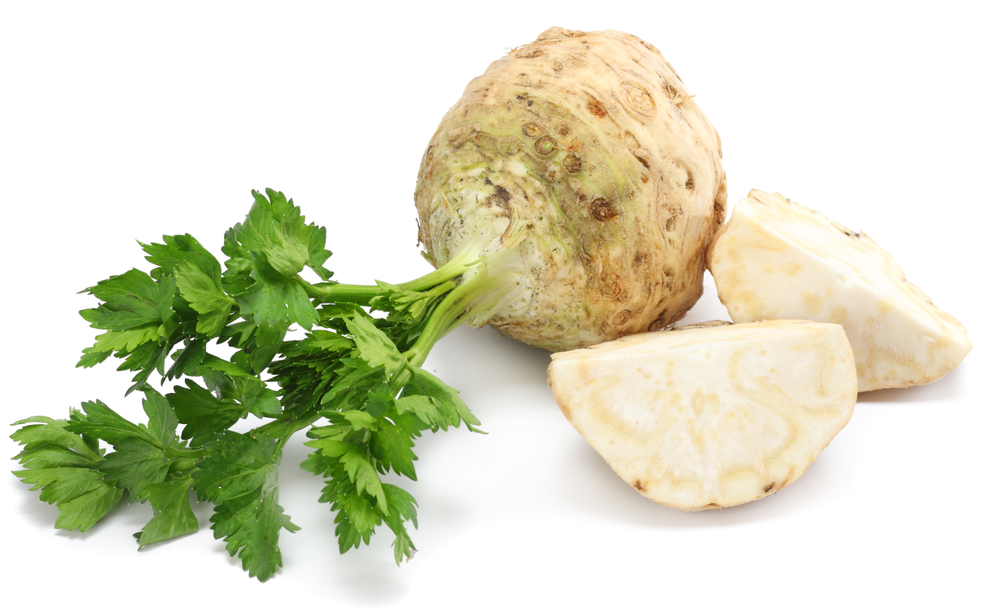
Celeriac is the root of a type of celery, from the Mediterranean area and northern Europe, but it is quite unknown in Spanish cuisine.
It is also known by its French name (celéri). It differs from the common celery (from which the stem and leaves are mainly used) in that its bulbous root is used, which is usually light brown and quite large (up to 1 kg.). This type of celery also has leaves but they are smaller and are not the main reason why it is grown but its bulb instead.
Its flavour will surprise you, because it is a bit sweet and reminds of parsley and celery. Let’s see why it is interesting:
NUTRITIONALLY
If we look only at the nutritional level (although we already know that this is only the tip of the iceberg), we see that it is low in calories (42 Kcal per 100g).
It contains very few carbohydrates (only 5%) and, in addition, its fat content is minimal and is quite low in protein.
Rich in vitamin K (fat-soluble, which participates to metabolize calcium) and C (antioxidant and that “reconstructs” vitamin E (excellent antioxidant). It makes iron available for our body (and prevent heart disease) and participates in liver cleansing. It also helps the nervous and immune systems because of its vitamin B6 content, which is functionally very important for aminoacids).
Its apigenin content is interesting, a flavonoid that helps prevent cancer.
It also contains minerals: In addition to phosphorus (component of bones and teeth and acid-alkaline balance control system in the blood), it contains potassium and manganese, a trace element that activates enzymes that metabolizes fats and carbohydrates.
A GLOBAL VISION
We already know that nothing works in isolation in nature, and food and its nutrients are no exception. Synergies often make the “the whole more than the sum of the parts” (Aristotle). Let´s have a look at some of its properties:
- It is good for weightloss and diabetes because it contains a small amount of carbohydrates, it is an ideal substitute for potatoes (which is a nightshade).
- It is good for the bones and prevents osteoporosis due to its vitamin K content and its interaction with calcium.
- It helps to cleanse the body: vitamins C and B6 favour liver cleansing while potassium prevents fluid retention.
- It’s rich in potassium, which regulates blood pressure.
… AND ENERGY-WISE, IS IT MORE YIN OR MORE YANG?
This goes beyond diets, we know that food is much more than a nutrient delivery system. Macrobiotics tells us about the energetics of food. It tells us, among other things, about whether a food is weakening and refreshing, or on the contrary is strengthening and warming.
We already know that nothing is yin or yang unless compared to something else. To know what energy properties a food has, we must look at aspects such as colour, taste, water content, the climate where it is grown, direction and speed of growth, texture, etc. We must look at the whole picture and determine which features actually stand out.
We know that it has very hard skin and is very resistant to cold (yang characteristics). It is grown during autumn and winter in northern Europe, yin climate and geographical area (humid and cold). This type of climate provides us with yang foods (strengthening, tonifying, warming) which help us keep warm and protect us in the winter.
On the other hand, we see that it has a fibrous texture and is brown. It does not grow very deep, since the bulb remains more or less below the soil, like an onion, so its yang energy is not as strong as that of a carrot or burdock. We could conclude that it is a fairly balanced food that we can include in our diet, if not daily, weekly, using more yang cooking styles (long sauteéing, baking, picklings, in soups, deep fried, etc).
AND HOW DO I COOK IT?
The good news is that you can use it as if it were a potato (you can use it in creams or soups, fried, tempura, baked, pureed, etc.
To cut it, do it in many different ways: large dice, small dice, into matchsticks, papa brava style … use your imagination and creativity! Here is a demonstration video I found.
The possible recipes are endless, as with any root or tuber. Try it in its simplest form, like celeriac cream with onion, simple and smooth. Or, with sweet potato and / or squash, to make it nutritious and digestive, or combined with fennel to have a more purifying effect if possible.
Bye for now! I wish you to try celery-turnip and incorporate it into your diet and leave you a recipe that you will surely love.
Enjoy and see you next time!






